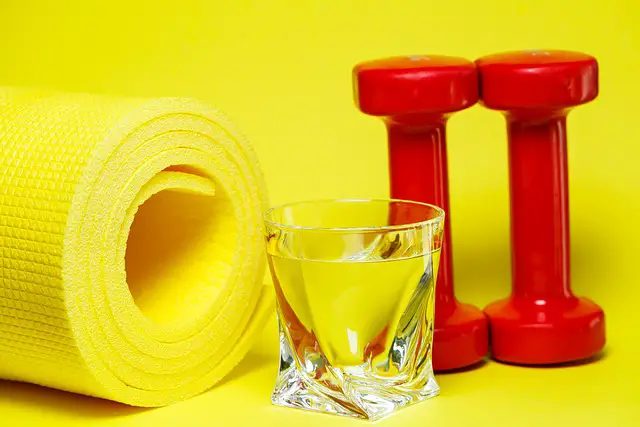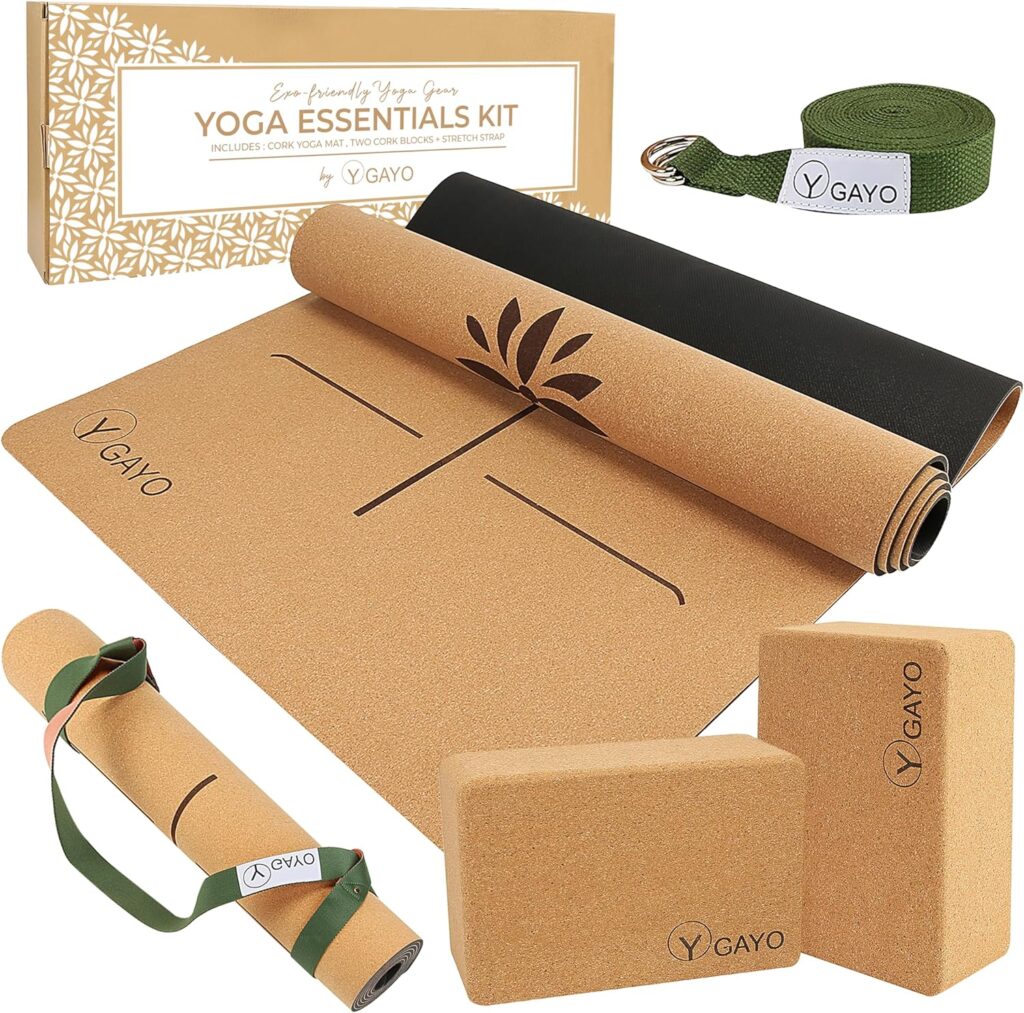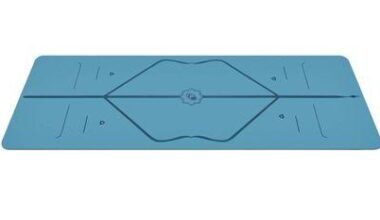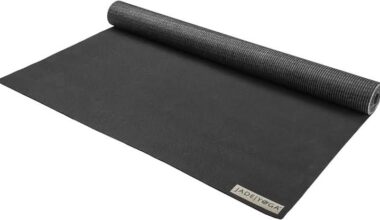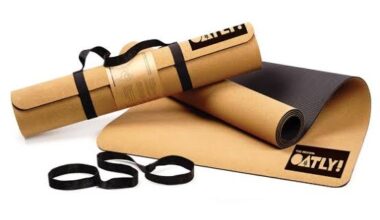Table of Contents Show
Unearth what to use in place of a yoga mat in this comprehensive guide, offering practical solutions to elevate your practice without breaking the bank. Don’t miss out on these creative ideas!
If you’re new to yoga or find yourself practicing without a mat, you might be wondering, “what to use in place of a yoga mat?” Don’t worry! There are plenty of alternatives that can provide a similar experience. In this comprehensive guide, we’ll delve into 8 fantastic options to help you get your zen on, even without a traditional yoga mat.
Disclosure: As an Amazon Associate I earn from qualifying purchases.
When it comes to choosing the perfect yoga mat, the debate of “cork vs rubber yoga mat” often comes up. But which one is truly the best? To answer that question, we’ve put together a comprehensive, engaging, and informative article that will not only help you understand the differences between these two materials but also guide you in making the right choice for your yoga practice. So, grab a cup of tea and settle in for the ultimate showdown!
The Power of Towels: Absorbent and Non-Slip
One of the easiest and most accessible alternatives to a yoga mat is a simple towel. Large, thick bath towels or beach towels can provide cushioning and support for your practice. Here’s how to make the most of your towel as a yoga mat replacement:
- Fold it: If you’re using a towel on a hard surface, folding it once or twice can provide extra padding for your knees and wrists.
- Non-slip backing: To avoid slipping, place a non-slip rug pad or shelf liner underneath your towel.
- Combine with a blanket: For even more cushioning, use a folded blanket underneath the towel.
Carpet and Rugs: Soft, Comfortable, and Already at Home
If you have a carpeted floor or a large rug, you’re in luck! These surfaces can serve as natural alternatives to yoga mats. The soft texture provides a comfortable surface for your practice, while the thickness offers some cushioning. To enhance your experience, try the following tips:
- Add a towel: If you find your hands or feet slipping on the carpet, place a towel on top for better grip.
- Use knee pads: For extra support, consider wearing knee pads or placing a folded towel under your knees during poses that require kneeling.
Foam Tiles: Modular and Customizable Support
Foam tiles, often used as play mats or workout flooring, can be an excellent alternative to yoga mats. They are easy to assemble, customizable, and provide a cushioned surface for your practice. Consider these tips when using foam tiles:
- Choose the right thickness: Look for foam tiles with a thickness of at least 0.5 inches for adequate support.
- Combine tiles: Create a larger practice area by connecting multiple tiles together.
- Clean regularly: Foam tiles can harbor bacteria, so be sure to clean them after each use with a gentle cleanser.
Cotton or Wool Blankets: Traditional and Time-Honored
Blankets made of natural fibers like cotton or wool can be a surprisingly effective substitute for a yoga mat. They provide a comfortable and supportive surface, and can easily be folded for extra padding. Here’s how to make the most of your blanket:
- Fold for support: Fold the blanket multiple times to create a cushioned surface.
- Use on a non-slip surface: To prevent slipping, place your blanket on a non-slip rug pad or carpeted area.
- Wash regularly: Keep your blanket fresh and clean by washing it regularly.
Outdoor Alternatives: Embrace Nature
If you’re practicing yoga outdoors, several natural surfaces can be used in place of a yoga mat. Some options include:
- Grass: The soft, natural texture of grass provides a comfortable surface for your practice. Just be sure to check for rocks or other debris before starting.
- Sand: If you’re at the beach, practicing on the sand can be a unique and enjoyable experience. The sand molds to your body, providing excellent support.
- Earth: A flat, smooth patch of dirt can be an ideal surface for practicing yoga. The earth provides natural cushioning and a strong connection to nature. Just be sure to choose a spot free of rocks or debris.
Exercise Mats: Versatile and Supportive
Though not specifically designed for yoga, exercise mats can work as a suitable alternative. They’re typically thicker than yoga mats, offering more cushioning and support for your joints. Keep these points in mind when using an exercise mat for yoga:
- Choose a non-slip surface: Ensure the exercise mat has a non-slip surface to prevent slipping during your practice.
- Wipe down after use: Clean your exercise mat after each session with a gentle cleanser to maintain hygiene.
- Fold for additional support: If you need extra cushioning for certain poses, fold the mat to provide more padding.
Yoga Socks and Gloves: Grip Where You Need It
If you’re practicing on a smooth surface like hardwood or tile, yoga socks and gloves can provide the grip you need without a mat. These special socks and gloves have non-slip grips on the bottom, helping you maintain your balance during poses. Keep in mind:
- Choose the right size: Ensure your yoga socks and gloves fit snugly for optimal grip and stability.
- Wash regularly: Keep your socks and gloves clean by washing them after each use.
- Combine with other alternatives: Yoga socks and gloves can be used in conjunction with other yoga mat alternatives like towels or blankets for added comfort and support.
DIY Yoga Mats: Get Crafty
If you’re feeling creative, you can make your yoga mat using materials you might already have at home. Some DIY yoga mat ideas include:
- Old clothes: Sew together several layers of old T-shirts or other fabric to create a cushioned, eco-friendly yoga mat.
- Cork: Glue a layer of cork to a non-slip backing for a unique, sustainable yoga mat.
- Rubber: Repurpose an old rubber mat or anti-fatigue mat as a yoga mat alternative. Make sure it has a non-slip surface and is easy to clean.
Pilates Mats: A Thicker, Supportive Cousin
Pilates mats are similar to yoga mats, but they tend to be thicker and more cushioned. This makes them a great alternative for those who need extra joint support during their practice. Just be aware that the extra thickness might make some balancing poses more challenging.
Adapting Your Practice: Yoga Without a Mat
Lastly, consider adapting your yoga practice to work without a mat altogether. Many poses can be performed comfortably on a carpeted surface or even while sitting in a chair. Experiment with different positions and modifications to find what works best for you.
You May Also Like: Do I Really Need a Yoga Mat for Yoga? Discover the Top 5 Revealing Insights
Conclusion
In conclusion, there are numerous alternatives for what to use in place of a yoga mat. From household items like towels and blankets to creative DIY solutions, there’s an option for every yogi. So, don’t let the absence of a yoga mat stop you from enjoying your practice – embrace the challenge and explore the possibilities!
Frequently Asked Questions (FAQs)
Q1: Can I practice yoga without a mat?
A1: Absolutely! While a mat can provide support and cushioning, it is not essential for a successful yoga practice. You can adapt your practice to work on different surfaces or use one of the many alternatives mentioned in this article.
Q2: What can I use for extra padding under my knees?
A2: If you need extra padding for your knees, consider using a folded towel, blanket, or a small cushion. Placing these items under your knees during poses that require kneeling can help alleviate pressure and discomfort.
Q3: Can I use a regular towel for hot yoga?
A3: Yes, you can use a regular towel for hot yoga. However, you might want to choose a towel with a high absorbency rate, like a microfiber towel, to help manage sweat during your practice. Additionally, placing a non-slip backing underneath the towel will help prevent slipping.
Q4: Are there any specific yoga mat alternatives for outdoor practice?
A4: When practicing outdoors, natural surfaces like grass, sand, or smooth dirt can be great alternatives to a yoga mat. Just make sure to check for any debris or rocks before starting your practice.
Q5: Is there a difference between a yoga mat and an exercise mat?
A5: Yes, there is a difference. Yoga mats are typically thinner and have a non-slip surface, specifically designed for yoga practice. Exercise mats are often thicker and provide more cushioning, making them suitable for various types of workouts, including yoga.
Q6: How can I make my DIY yoga mat more slip-resistant?
A6: To make your DIY yoga mat more slip-resistant, try adding a non-slip backing or coating to the bottom side of the mat. You can use materials like shelf liners, rug pads, or non-slip sprays to achieve this.
Q7: Can I use a Pilates mat for yoga?
A7: Yes, you can use a Pilates mat for yoga. Pilates mats are generally thicker than yoga mats, providing more cushioning and support. However, keep in mind that the extra thickness may make balancing poses more challenging.
Q8: How do I clean my yoga mat alternative?
A8: The cleaning process will depend on the material of your alternative. For most options, like towels, blankets, and foam tiles, use a gentle cleanser and water to wipe down the surface after each use. For items like socks and gloves, wash them according to the manufacturer’s instructions.
Q9: Do I need to invest in a high-quality yoga mat if I am a beginner?
A9: While a high-quality yoga mat can provide additional comfort and support, it is not necessary for beginners. Many of the alternatives mentioned in this article can be used as a cost-effective way to start your practice before investing in a specialized yoga mat.
